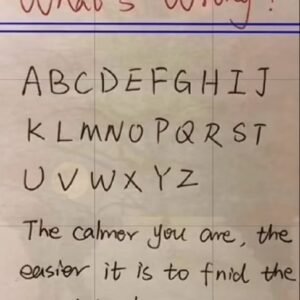Visual puzzles have long captured the curiosity of people across the internet, and this newest brain teaser is the latest to leave users scratching their heads.
The image features a woman holding a broom, standing calmly inside a warm and inviting home. The scene is filled with cozy details—colorful walls, a tidy room, and soft lighting—that make the illustration appear ordinary at first glance. But there’s a catch: somewhere in this seemingly simple image, a cleverly hidden cat is camouflaged into the background.
According to the original post circulating online, 99% of people fail to find the cat on their first try. Based on thousands of comments and reactions across social media platforms, that claim doesn’t seem exaggerated. Many viewers admit they’ve stared at the image for several minutes—or even longer—without spotting anything unusual. Some users say they thought the challenge was a trick or that there wasn’t a cat at all. But the cat is there. You just need to look very, very carefully.
What makes this puzzle so frustrating—and yet so entertaining—is the way the cat has been integrated into the environment. It’s not sitting on…
Visual puzzles have long captured the curiosity of people across the internet, and this newest brain teaser is the latest to leave users scratching their heads. The image features a woman holding a broom, standing calmly inside a warm and inviting home.
The scene is filled with cozy details—colorful walls, a tidy room, and soft lighting—that make the illustration appear ordinary at first glance. But there’s a catch: somewhere in this seemingly simple image, a cleverly hidden cat is camouflaged into the background.
According to the original post circulating online, 99% of people fail to find the cat on their first try. Based on thousands of comments and reactions across social media platforms, that claim doesn’t seem exaggerated. Many viewers admit they’ve stared at the image for several minutes—or even longer—without spotting anything unusual. Some users say they thought the challenge was a trick or that there wasn’t a cat at all. But the cat is there. You just need to look very, very carefully.
What makes this puzzle so frustrating—and yet so entertaining—is the way the cat has been integrated into the environment. It’s not sitting on a table or under a chair, like you might expect. Instead, the feline is seamlessly blended into the background, making use of shadows, textures, and colors to hide in plain sight. The more you stare, the more your brain starts playing tricks on you. Your eyes scan the entire room, looking for something obvious, but the design of the image challenges your assumptions and forces you to look deeper.
If you’re feeling stuck, here’s a helpful hint: focus your attention not just on the objects in the room, but on the patterns and shapes that make up the background. Look closely at the woman’s apron, the folds in her dress, and the nearby wall. Somewhere in that area, the cat’s body is subtly outlined, hidden within the design like a ghostly silhouette. Its features aren’t bold or cartoonish—they’re soft and subdued, blending almost perfectly with the surrounding elements.
Once you finally spot the cat, the moment of realization is both satisfying and surprising. Many people report that they feel silly for not having seen it sooner, because once it’s pointed out, it seems so obvious. That’s part of the puzzle’s appeal: it plays with your perception, highlighting how the human brain often overlooks details when it assumes it already knows what it’s seeing.
Puzzles like this one aren’t just fun—they also offer a deeper insight into how our minds process visual information. They show us that sometimes, in order to see what’s really there, we need to slow down, change our perspective, and take a second (or third) look. It’s a reminder that our brains don’t always interpret reality exactly as it is. Sometimes, the truth is right in front of us—we just need to learn how to look.
So, the next time you’re faced with a visual challenge like this, don’t rush. Sit back, breathe, and observe. You might just train your brain to see what others miss—and join the lucky 1% who spot the hidden cat without any help.




